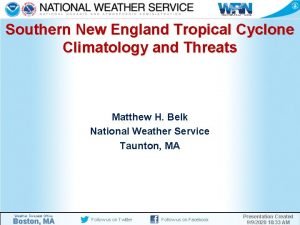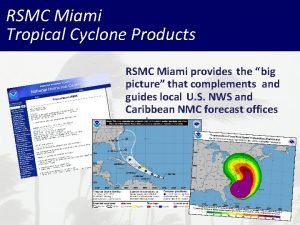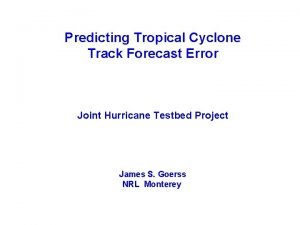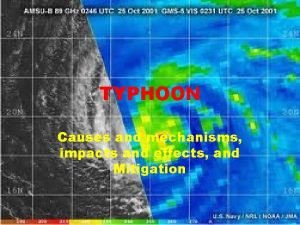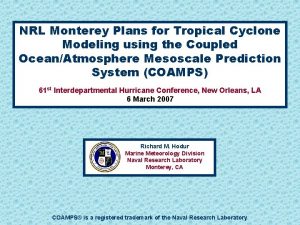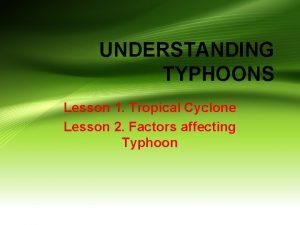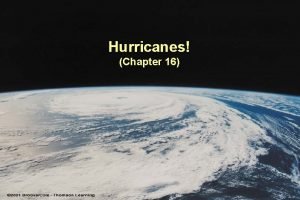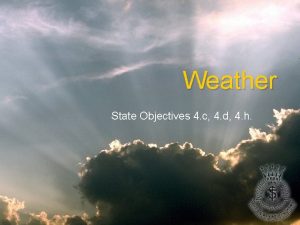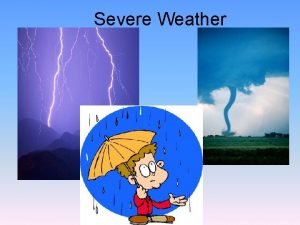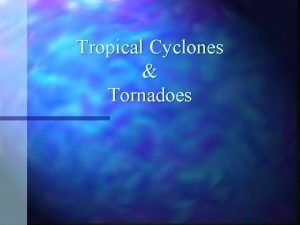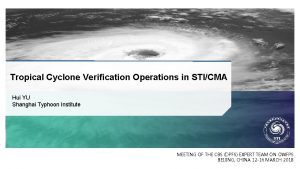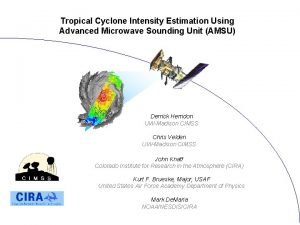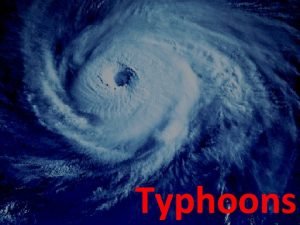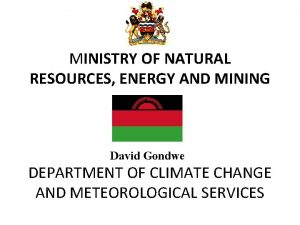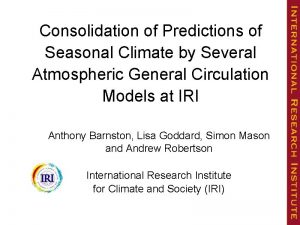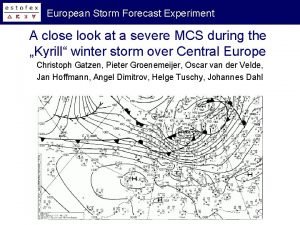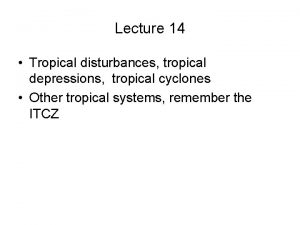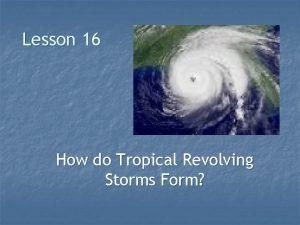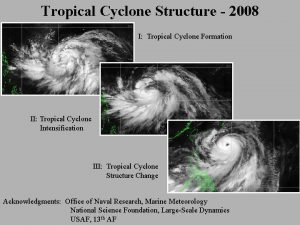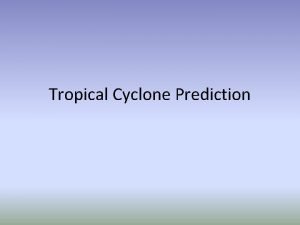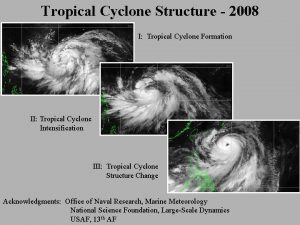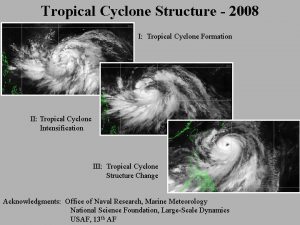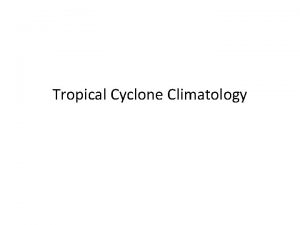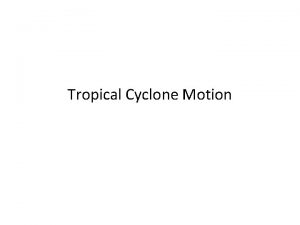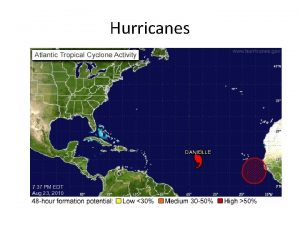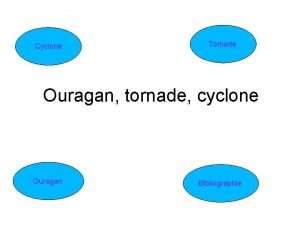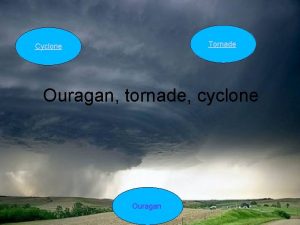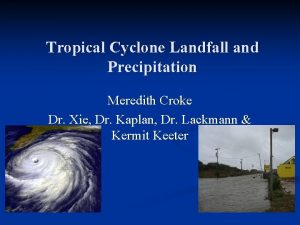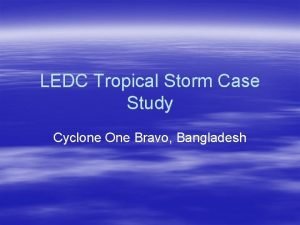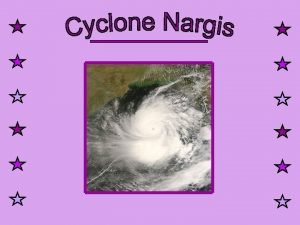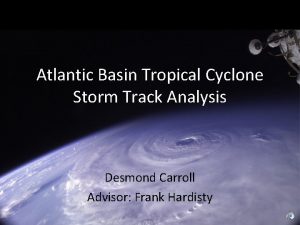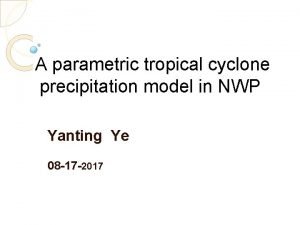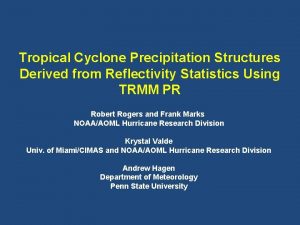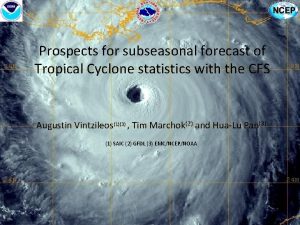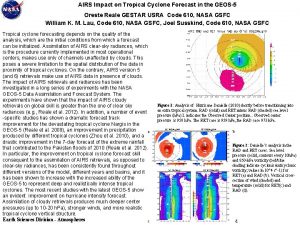Tropical cyclone TC trajectory and storm precipitation forecast
























- Slides: 24

Tropical cyclone (TC) trajectory and storm precipitation forecast improvement using SFOV AIRS soundings Jun Li@, Tim Schmit&, Hui Liu#, Jinlong Li@, Jing Zheng@, Bin Wang%, and Elisabeth Weisz@ &Center for Satellite Applications and Research, NOAA/NESDIS @CIMSS/SSEC, #National %Institute University of Wisconsin-Madison Center for Atmospheric Research of Atmospheric Physics, Chinese Academy of Sciences Satellite Hyperspectral Sensor Workshop Miami, Florida March 29 -31, 2011 Supported by NOAA JPSS and GOES-R programs 1

Objective • Help understand on assimilating the advanced IR water vapor information for NWP • Improve tropical cyclone track and intensity forecast by assimilating advanced IR soundings in regional NWP models; improve the severe storm forecast by assimilating advanced IR soundings in regional NWP models • Evaluate advanced IR soundings where in-situ measurements are rare (JPSS) • Prompt the application of advanced IR sounding products in regional forecast by impact studies (JPSS) • Use high-spectral resolution polar-orbiting information combined with high temporal information from GOES-R

Methodologies/technical approaches • Using advanced IR soundings (AIRS, next IASI and in future Cr. IS) in hurricane forecast through WRF/DART forecast/assimilation system. – 2 -day assimilation followed by 4 -day forecast for Hurricane Ike (2008) – 1 -day assimilation followed by 2 -day forecast for Typhoon Sinlaku (2008) • Using advanced IR soundings in hurricane forecast through WRF/3 DVAR forecast/assimilation system – 48 hour forecast for Hurricane Ike (2008) • Assimilating advanced IR soundings in regional NWP models for storm forecast through AREM/4 DVAR – 24 hour precipitation forecast 3

Assimilating advanced IR soundings with WRF/DART – hurricane/typhoon forecast experiments • ~10 AIRS granules over the regional WRF domain • Full spatial resolution AIRS soundings (13. 5 km at nadir) are derived using CIMSS hyperspectral infrared sounding retrieval (CHISR) algorithm • Clear sky only soundings are used – Future work could include soundings in partial cloud cover • Ensemble assimilation of AIRS soundings followed by ensemble forecast (36 km resolution) – CTL run: Assimilate radiosonde, satellite cloud winds, Quik. SCAT winds, aircraft data, COSMIC GPS refractivity, ship, and land surface data. – AIRS run: Same as CTL run plus AIRS full spatial resolution T and Q soundings 4

Hurricane Ike (2008): Retrieved 500 h. Pa temperature 2008. 09. 06 – Used in assimilation) (K) CIMSS/UW Clear sky AIRS single field-of-view temperature retrievals at 500 h. Pa on 06 September 2008, each pixel provides vertical temperature and moisture soundings. 5

Hurricane Ike (2008): Retrieved 500 h. Pa temperature 2008. 09. 07 – Used in assimilation) (K) CIMSS/UW Clear sky AIRS single field-of-view temperature retrievals at 500 h. Pa on 07 September 2008, each pixel provides vertical temperature and moisture soundings.

Tracks of ensemble mean analysis on Hurricane IKE CTL run: Assimilate radiosonde, satellite cloud winds, aircraft data, and surface data. AIRS Analysis from 06 UTC 6 to 00 UTC 8 September 2008 7

Sea Level Pressure of ensemble mean analysis on Hurricane IKE AIRS Analysis from 06 UTC 6 to 00 UTC 8 September 2008 8

Forecast Experiments on Ike (2008) • 4 -day ensemble forecasts (16 members) from the analyses on 00 UTC 8 September 2008. • Track trajectory and hurricane surface central pressure are compared (every 6 -hourly in the plots). 9

Tracks of 96 h forecasts on Hurricane IKE CTRL run: Assimilate radiosonde, satellite AIRS cloud winds, aircraft data, and surface data. No AIRS Red is observation, green is forecast Forecasts start at 00 UTC 8 September 2008 With AIRS

Without AIRS With AIRS Track error (upper two panels) and sea level pressure from 96 hour forecasts (start at 00 UTC 8 September 2008) 11

Typhoon Sinlaku (2008) Fact Sinlaku Path Sinlaku rapid intensification observed 12

Typhoon Sinlaku (2008): Retrieved 700 h. Pa water vapor mixing ratio 2008. 09 – Used in assimilation) (g/kg) (K) 700 h. Pa water vapor mixing ratio (g/kg) in clear skies (Sinlaku – 09 September 2008)

Typhoon Sinlaku (2008): Retrieved 700 h. Pa water vapor mixing ratio 2008. 09. 10 – Used in assimilation) (g/kg) (K) 700 h. Pa water vapor mixing ratio (g/kg) in clear skies (Sinlaku – 10 September 2008)

Track and Intensity Analyses for Sinlaku (2008) CIMSS-T: AIRS SFOV temperature CIMSS-Q: AIRS SFOV water vapor CIMSS-TQ: AIRS SFOV temperature and water vapor Rapid intensification from 9 – 10 September 2011 – water vapor soundings are important!

Verify forecast/analysis with geostationary IR images Obs erv ed M TSA T IR 10. 8 μm Sim ulat ed M TSA T IR Ima ges 6. 75 μm Ima ges

Assimilating advanced IR soundings with WRF/3 DVAR - Hurricane forecast experiments • 2008090606_WRF/3 DVAR • CTRL run: use NCEP 6 -hour final operational global analysis (1. 0 x 1. 0 degree grids; http: //dss. ucar. edu/datasets/ds 083. 2/), including radiosondes, satellite winds, pilot report, GPS, ship, profiler, surface observations etc. , starting at 06 UTC 06 September 2008 • AIRS (Control + AIRS) run: use clear-skies from granules g 066/067/068, but only assimilate 13 levels of AIRS SFOV temperature profiles between 500 and 800 h. Pa • Comparisons of Hurricane track for the next 48 hour forecast 17

AIRS 2008090606_g 066, g 067, g 068 AIRS 700 h. Pa temperature (upper left) WRF 700 h. Pa background temperature (lower left panel) The temperature difference between the AIRS and WRF background at 06 UTC on 06 September 2008 (lower right panel).

48 hour forecast starting at 06 UTC 06 September 2008 CTRL AIRS Control run with NCEP analysis, including radiosondes, satellite winds, pilot report, GPS, ship, profiler, surface observation, etc. AIRS run

48 hour forecast track bias (assimilate 500 – 800 h. Pa AIRS_T) 48 hour forecast SLP (assimilate 500 -800 h. Pa AIRS_T) strongest

Assimilating advanced IR soundings with AREM/4 DVAR – Storm precipitation forecast experiment • Control Run: NCEP-FNL analysis • AIRS Run 1: – Assimilate AIRS T/Q at 2009072206 • AIRS Run 2: – Assimilate AIRS T/Q at 2009072206 and 2009072218 – Assimilating window: 00 – 06 UTC and 12 – 18 UTC 2009072206 300 h. Pa AIRS temperature 2009年 7月22日~ 23日 2009072218

OBS CTRL 24 -hour Precipitation Forecast AIRS Run 1 AIRS Run 2

Summary • AIRS SFOV temperature and water vapor soundings improve both the track and intensity forecast for Hurricane Ike (2008) and Typhoon Sinlaku (2008) with both WRF/DART and WRF/3 DVAR simulation and forecast systems. • AIRS SFOV moisture soundings significantly improve the definition of the typhoon vortex in the analysis and the forecast of the rapid intensification for Typhoon Sinlaku (2008). • AIRS SFOV temperature and moisture soundings improve 24 hour precipitation forecast with AREM/4 DVAR. 23

Select References • Li, J. , H. Liu, 2009: Improved hurricane track and intensity forecast usingle field-of-view advanced IR sounding measurements, Geophysical Research Letters, 36, L 11813, doi: 10. 1029/2009 GL 038285. • Liu, H. , and J. Li, 2010: An improvement in forecast of rapid intensification of typhoon Sinlaku (2008) using clear sky full spatial resolution advanced IR soundings, Journal of Applied Meteorology and Climate, 49, 821 – 827. • Li, J. , H. Liu, and T. Schmit, 2010: Advanced infrared water vapor measurements improve hurricane forecasts. SPIE, 012337/FAE 9473 B/000053. (http: //spie. org/x 42479. xml? highlight=x 2420&Article. ID=x 42479) • Wang, B. , J. Liu, S. Wang, W. Cheng, J. Liu, C. Liu, Q. Xiao, and Y. Kuo, 2010: An Economical Approach to Four-dimensional Variational Data Assimilation. Adv. Atmos. Sci. , 27, 715 - 727. • Weisz, E. , J. Li, Jinlong Li, D. K. Zhou, H. -L. Huang, M. D. Goldberg, and P. Yang, 2007: Cloudy sounding and cloud-top height retrieval from AIRS alone single field-of-view radiance measurements, Geophysical Research Letters, 34, L 12802, doi: 10. 1029/2007 GL 030219. 24
 Hurricane tropical storm forecast
Hurricane tropical storm forecast Tropical storm forecast florida
Tropical storm forecast florida Hurricane tropical storm forecast
Hurricane tropical storm forecast Co precipitation and post precipitation
Co precipitation and post precipitation Co precipitation and post precipitation
Co precipitation and post precipitation Formative stage of typhoon
Formative stage of typhoon Nrl monterey tropical cyclone
Nrl monterey tropical cyclone Understanding typhoons
Understanding typhoons Hurricane cross section
Hurricane cross section Parts of tropical cyclone
Parts of tropical cyclone Map of tornado alley
Map of tornado alley Weather disturbances
Weather disturbances Tropical cyclone tornadoes
Tropical cyclone tornadoes Tropical cyclone
Tropical cyclone Tropical cyclone
Tropical cyclone A recipe of a tropical cyclone
A recipe of a tropical cyclone Conclusion of tropical cyclone dineo
Conclusion of tropical cyclone dineo Iri multi-model probability forecast for precipitation
Iri multi-model probability forecast for precipitation European storm forecast
European storm forecast Personification examples for the sun
Personification examples for the sun Eye wall
Eye wall Hurricane cross
Hurricane cross Tropical storm andes
Tropical storm andes Tropical storm andes
Tropical storm andes How do tropical storms form
How do tropical storms form
